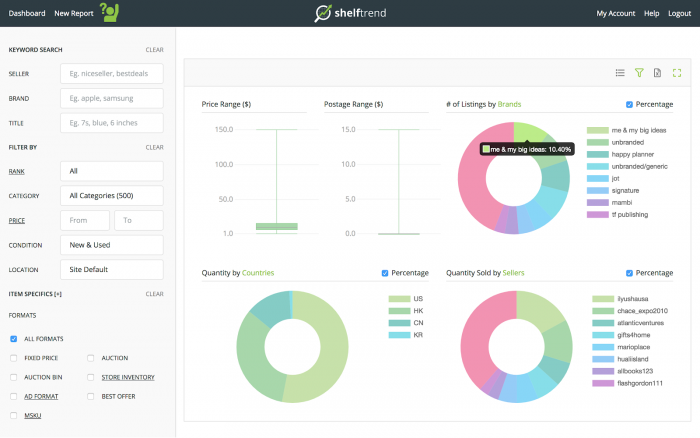If you own an online store, expanding onto an e-commerce marketplace like eBay is an excellent opportunity to reach more customers. However, like all small businesses with multiple conflicting priorities, it is easily put into the too-hard-basket.
Before you put off the idea of selling on eBay completely, keep in mind that certain eBay listing software can assist with the endeavor. Here is a simple step-by-step walk-through on how to research, quantify and determine whether selling on eBay could be the right expansion model for your business.
Get a solid sales estimate of the opportunity
Having realistic expectations of sales will help you determine whether selling on eBay is an endeavour worth pursuing. To create a solid sales estimate, we must first identify the segment of the marketplace you are selling in.
eBay has tens of thousands of categories and over a billion of product listings. Although it seems daunting, your competitive space will never directly involve millions or even thousands of listings.
Define your segment of the eBay marketplace
A rule of thumb to consider is that the average eBay buyer will likely make their purchase within the first ten pages of their eBay search, if not from the first page or even the top 3 listings within search results! As such, being within the top 500 product listings (the first 10 pages) of eBay’s Best Match search ranking is absolutely critical if you’re going to make sales.
Selling on eBay, like your online store, is search driven. As you’ve probably done in the past, you will need to do your keyword research to understand how buyers are finding your products. Although it is a different platform, Google Analytics is not a bad way of obtaining a first cut of product keywords to test on eBay, especially as many eBay purchases start with a Google search.
Research keywords driving buyers to the products in your online store. Then test those keywords on eBay. Take notice of any recommended search terms from eBay or related keywords.
When you’ve confidently identified the best keywords on eBay to find products such as yours, you’ve also isolated a section of eBay’s marketplace where you will be selling. This is your market, your competitive space.
Size the sales potential
Next, plug those keywords into a tool like ShelfTrend‘s Supply Demand Report. This free tool and report will give you the average weekly sales of the highest ranked listings for those keywords. You can dig deeper into each product listing and seller to understand how much of the market they represent.
Having an estimate of weekly sales will help you determine whether the marketplace opportunity is worth further investigation. You may need to sharpen your keyword research a bit and run the report a few times to get the right perspective, but at least you have a benchmark to compare against.
Assess how your product could fare against the competition on eBay
Now that you’ve isolated your market segment and have established a realistic estimate of sales potential, you need to assess the competition.
Do some competitive analysis
Using the same keywords for researching weekly sales, run ShelfTrend’s Live Listings – Top 500 report. This report summarizes the top 500 product listings (the first 10 pages) of eBay’s Best Match search rank.
From a complex algorithm in the backend, eBay has determined that these listings are the most likely to make a sale from a historical sales and buyer data point of view. It is also precisely these 500 listings that the buyer will be comparing your product against as they make their purchase decision.
ShelfTrend’s Live Listings – Top 500 report summarizes your competitive space. Get to know:
- the price range the buyer is considering,
- the number of sellers selling similar products,
- the popular brands and product features.
For example, a search for planners using ShelfTrend’s Live Listings report (chart view) provides a quick snapshot of the competitive space.
eBay is constantly ranking and re-sorting listings as data on buyer demand and sales is processed. In high velocity categories and keywords, product features can rise and fall in rank in response to what has been selling. Run the report regularly to see how your competitive environment has changed from the last time you checked.
Is eBay saturated by identical or similar products? How are they priced? Explore the data. Build some hypotheses and investigate your hunches. By understanding the competition well, you’ll be able to better position and price your products to be competitive.
Learn from the best
Part of the process of studying the marketplace is to identify who is also playing on the same field selling the same or similar products.
Will you be competing against one or two large eBay sellers, or many smaller sellers? The same ShelfTrend tools can be used to research leading competitors, their sales metrics and best performing listings.
Another benefit of watching bigger successful sellers is to learn how they have optimized their listings and product offerings. Although eBay is an easy place to start selling, mastering its idiosyncrasies, especially for a large number of products across multiple categories, can be very challenging.
Here are some areas where seasoned professional eBay sellers have spent years perfecting throughout their careers and is worth considering when analyzing their listings:
- Title optimization – listing titles determine what is, and is not, included in search results. This makes it important to include as many relevant keywords as possible in your title.
- Format types – only the very experienced seller is able to best utilize the different types of eBay selling formats to their advantage as part of their sales strategy.
- Business policies – determines their level of customer service. If they are a dominant and large seller, they could be setting what a buyer considers the minimum standard for sale.
- Structured data – eBay indexes listings with the clearest and best structured product information, at the minimum through item specifics but preferably through catalogues. It is now expected that most products listed on eBay are provided with a product identifier. The more information you provide about your listing, the better eBay is able to index it and the easier a buyer will find your product.
- Photos – You might think that the photos you use on your online store can be easily transferred over, and although it could be the case, remember that your photos in a completely different buying environment could also confuse your buyer. Research the type of photos that other sellers are presenting to buyers and emulate the style.
Selling on eBay can seem daunting, but millions of sellers are doing it, so why couldn’t you? Gain some confidence by putting a little bit of time into researching the market’s potential. Have a look through the product range and assess the price points, the product features and what is selling. Learn from your competitors and benchmark their products and sales. With hundreds of millions of global buyers, there is definitely a sale to be had if you’re ready to make that plunge.
Find a Home-Based Business to Start-Up >>> Hundreds of Business Listings.

















































